Sungjoon Park
Interpretable Convolutional SyncNet
Sep 02, 2024Abstract:Because videos in the wild can be out of sync for various reasons, a sync-net is used to bring the video back into sync for tasks that require synchronized videos. Previous state-of-the-art (SOTA) sync-nets use InfoNCE loss, rely on the transformer architecture, or both. Unfortunately, the former makes the model's output difficult to interpret, and the latter is unfriendly with large images, thus limiting the usefulness of sync-nets. In this work, we train a convolutional sync-net using the balanced BCE loss (BBCE), a loss inspired by the binary cross entropy (BCE) and the InfoNCE losses. In contrast to the InfoNCE loss, the BBCE loss does not require complicated sampling schemes. Our model can better handle larger images, and its output can be given a probabilistic interpretation. The probabilistic interpretation allows us to define metrics such as probability at offset and offscreen ratio to evaluate the sync quality of audio-visual (AV) speech datasets. Furthermore, our model achieves SOTA accuracy of $96.5\%$ on the LRS2 dataset and $93.8\%$ on the LRS3 dataset.
FedTherapist: Mental Health Monitoring with User-Generated Linguistic Expressions on Smartphones via Federated Learning
Oct 25, 2023Abstract:Psychiatrists diagnose mental disorders via the linguistic use of patients. Still, due to data privacy, existing passive mental health monitoring systems use alternative features such as activity, app usage, and location via mobile devices. We propose FedTherapist, a mobile mental health monitoring system that utilizes continuous speech and keyboard input in a privacy-preserving way via federated learning. We explore multiple model designs by comparing their performance and overhead for FedTherapist to overcome the complex nature of on-device language model training on smartphones. We further propose a Context-Aware Language Learning (CALL) methodology to effectively utilize smartphones' large and noisy text for mental health signal sensing. Our IRB-approved evaluation of the prediction of self-reported depression, stress, anxiety, and mood from 46 participants shows higher accuracy of FedTherapist compared with the performance with non-language features, achieving 0.15 AUROC improvement and 8.21% MAE reduction.
Analyzing Norm Violations in Live-Stream Chat
May 18, 2023



Abstract:Toxic language, such as hate speech, can deter users from participating in online communities and enjoying popular platforms. Previous approaches to detecting toxic language and norm violations have been primarily concerned with conversations from online forums and social media, such as Reddit and Twitter. These approaches are less effective when applied to conversations on live-streaming platforms, such as Twitch and YouTube Live, as each comment is only visible for a limited time and lacks a thread structure that establishes its relationship with other comments. In this work, we share the first NLP study dedicated to detecting norm violations in conversations on live-streaming platforms. We define norm violation categories in live-stream chats and annotate 4,583 moderated comments from Twitch. We articulate several facets of live-stream data that differ from other forums, and demonstrate that existing models perform poorly in this setting. By conducting a user study, we identify the informational context humans use in live-stream moderation, and train models leveraging context to identify norm violations. Our results show that appropriate contextual information can boost moderation performance by 35\%.
Towards standardizing Korean Grammatical Error Correction: Datasets and Annotation
Oct 27, 2022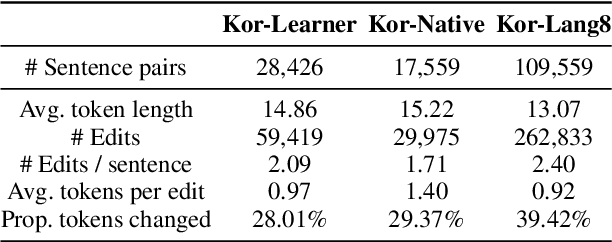

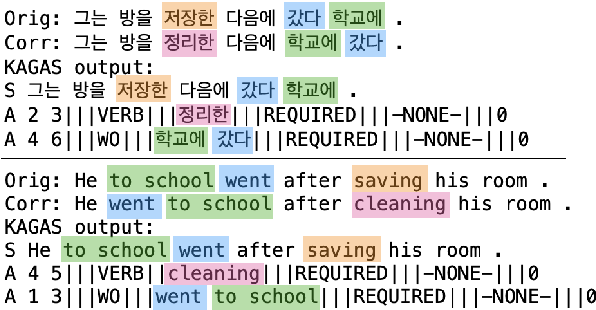

Abstract:Research on Korean grammatical error correction (GEC) is limited compared to other major languages such as English and Chinese. We attribute this problematic circumstance to the lack of a carefully designed evaluation benchmark for Korean. Thus, in this work, we first collect three datasets from different sources (Kor-Lang8, Kor-Native, and Kor-Learner) to cover a wide range of error types and annotate them using our newly proposed tool called Korean Automatic Grammatical error Annotation System (KAGAS). KAGAS is a carefully designed edit alignment & classification tool that considers the nature of Korean on generating an alignment between a source sentence and a target sentence, and identifies error types on each aligned edit. We also present baseline models fine-tuned over our datasets. We show that the model trained with our datasets significantly outperforms the public statistical GEC system (Hanspell) on a wider range of error types, demonstrating the diversity and usefulness of the datasets.
KOLD: Korean Offensive Language Dataset
May 23, 2022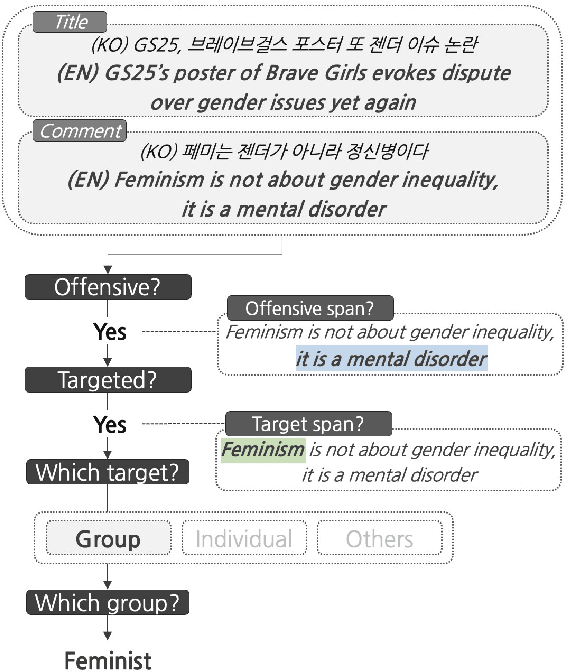
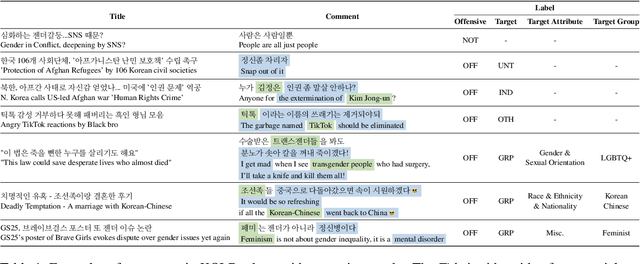
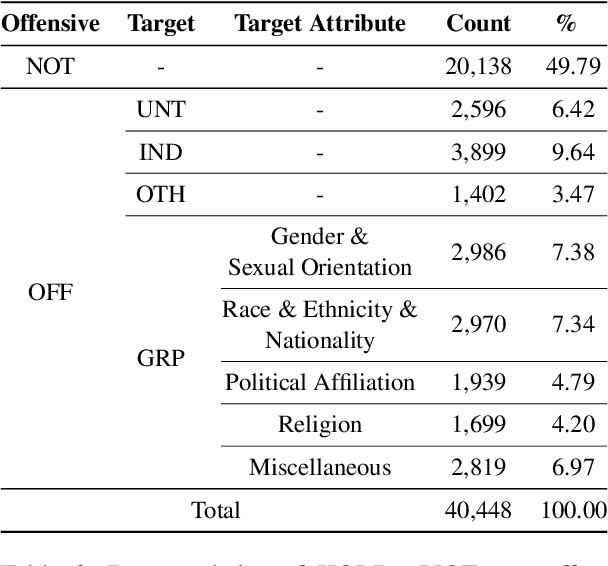
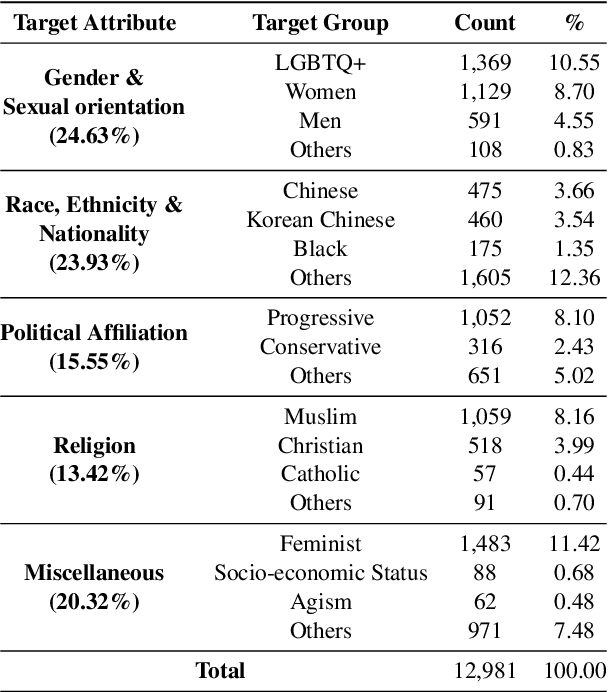
Abstract:Although large attention has been paid to the detection of hate speech, most work has been done in English, failing to make it applicable to other languages. To fill this gap, we present a Korean offensive language dataset (KOLD), 40k comments labeled with offensiveness, target, and targeted group information. We also collect two types of span, offensive and target span that justifies the decision of the categorization within the text. Comparing the distribution of targeted groups with the existing English dataset, we point out the necessity of a hate speech dataset fitted to the language that best reflects the culture. Trained with our dataset, we report the baseline performance of the models built on top of large pretrained language models. We also show that title information serves as context and is helpful to discern the target of hatred, especially when they are omitted in the comment.
Improving Tagging Consistency and Entity Coverage for Chemical Identification in Full-text Articles
Nov 20, 2021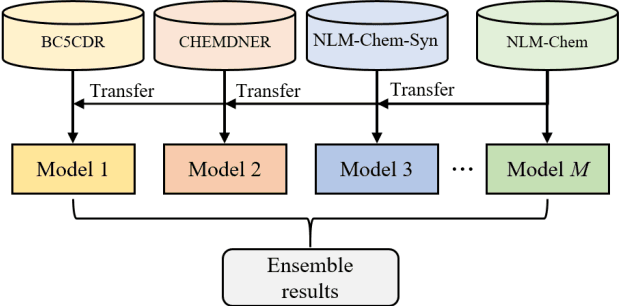
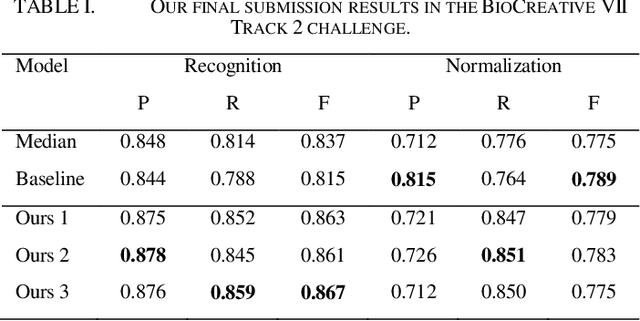
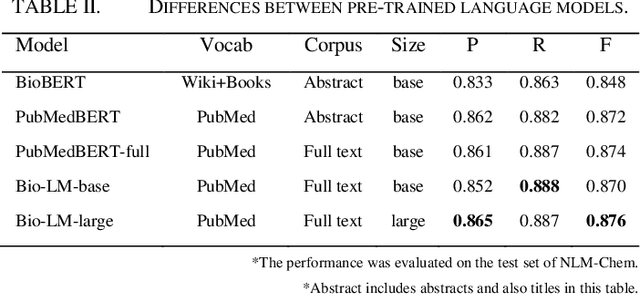
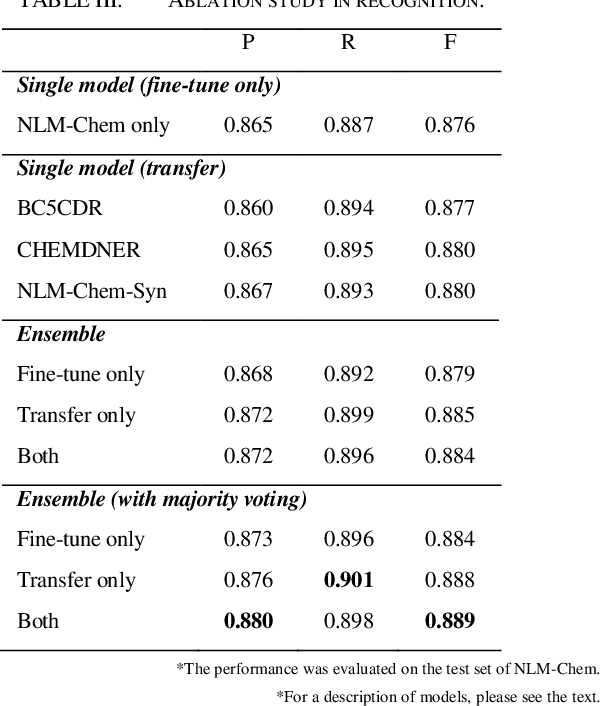
Abstract:This paper is a technical report on our system submitted to the chemical identification task of the BioCreative VII Track 2 challenge. The main feature of this challenge is that the data consists of full-text articles, while current datasets usually consist of only titles and abstracts. To effectively address the problem, we aim to improve tagging consistency and entity coverage using various methods such as majority voting within the same articles for named entity recognition (NER) and a hybrid approach that combines a dictionary and a neural model for normalization. In the experiments on the NLM-Chem dataset, we show that our methods improve models' performance, particularly in terms of recall. Finally, in the official evaluation of the challenge, our system was ranked 1st in NER by significantly outperforming the baseline model and more than 80 submissions from 16 teams.
KLUE: Korean Language Understanding Evaluation
Jun 11, 2021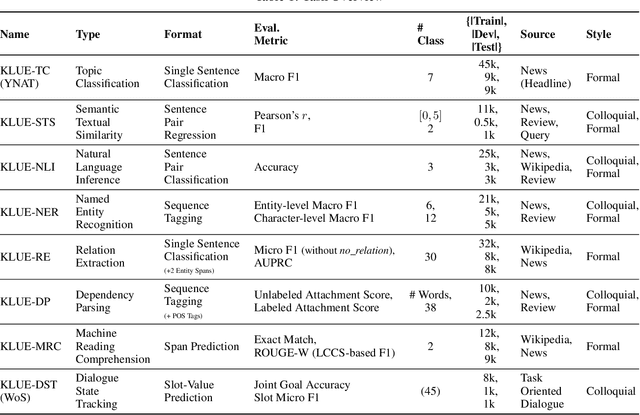

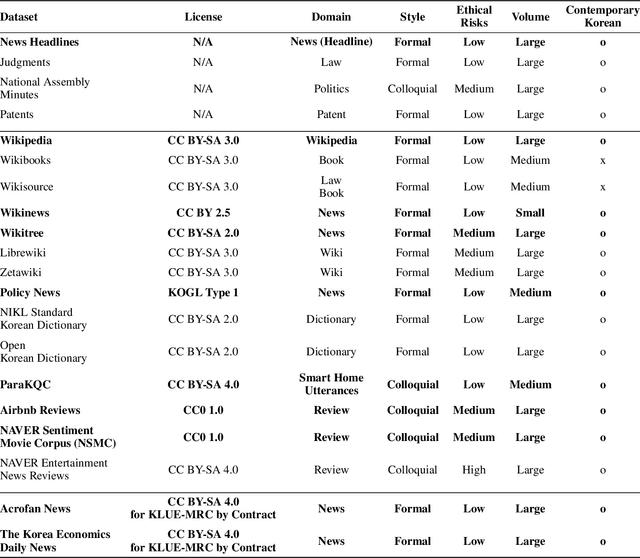
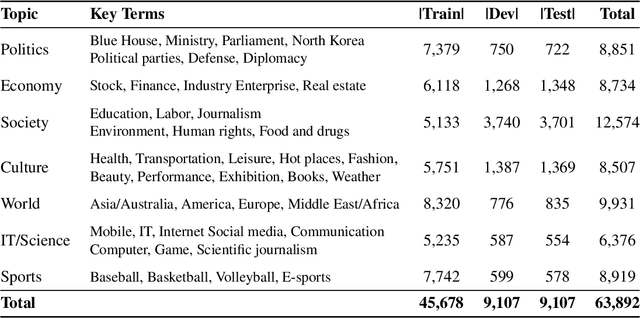
Abstract:We introduce Korean Language Understanding Evaluation (KLUE) benchmark. KLUE is a collection of 8 Korean natural language understanding (NLU) tasks, including Topic Classification, SemanticTextual Similarity, Natural Language Inference, Named Entity Recognition, Relation Extraction, Dependency Parsing, Machine Reading Comprehension, and Dialogue State Tracking. We build all of the tasks from scratch from diverse source corpora while respecting copyrights, to ensure accessibility for anyone without any restrictions. With ethical considerations in mind, we carefully design annotation protocols. Along with the benchmark tasks and data, we provide suitable evaluation metrics and fine-tuning recipes for pretrained language models for each task. We furthermore release the pretrained language models (PLM), KLUE-BERT and KLUE-RoBERTa, to help reproducing baseline models on KLUE and thereby facilitate future research. We make a few interesting observations from the preliminary experiments using the proposed KLUE benchmark suite, already demonstrating the usefulness of this new benchmark suite. First, we find KLUE-RoBERTa-large outperforms other baselines, including multilingual PLMs and existing open-source Korean PLMs. Second, we see minimal degradation in performance even when we replace personally identifiable information from the pretraining corpus, suggesting that privacy and NLU capability are not at odds with each other. Lastly, we find that using BPE tokenization in combination with morpheme-level pre-tokenization is effective in tasks involving morpheme-level tagging, detection and generation. In addition to accelerating Korean NLP research, our comprehensive documentation on creating KLUE will facilitate creating similar resources for other languages in the future. KLUE is available at https://klue-benchmark.com.
Toward Dimensional Emotion Detection from Categorical Emotion Annotations
Nov 06, 2019



Abstract:We propose a framework which makes a model predict fine-grained dimensional emotions (valence-arousal-dominance, VAD) trained on corpus annotated with coarse-grained categorical emotions. We train a model by minimizing EMD distances between predicted VAD score distribution and \textit{sorted} categorical emotion distributions in terms of VAD, as a proxy of target VAD score distributions. With our model, we can simultaneously classify a given sentence to categorical emotions as well as predict VAD scores. We use pre-trained BERT-Large and fine-tune on SemEval dataset (11 categorical emotions) and evaluate on EmoBank (VAD dimensional emotions), in order to show our approach reaches comparable performance to that of the state-of-the-art classifiers in categorical emotion classification task and significant positive correlations with ground truth VAD scores. Also, if one continues training our model with supervision of VAD labels, it outperforms state-of-the-art VAD regression models. We further present examples showing our model can annotate emotional words suitable for a given text even those words are not seen as categorical labels during training.
Conversation Model Fine-Tuning for Classifying Client Utterances in Counseling Dialogues
Mar 31, 2019



Abstract:The recent surge of text-based online counseling applications enables us to collect and analyze interactions between counselors and clients. A dataset of those interactions can be used to learn to automatically classify the client utterances into categories that help counselors in diagnosing client status and predicting counseling outcome. With proper anonymization, we collect counselor-client dialogues, define meaningful categories of client utterances with professional counselors, and develop a novel neural network model for classifying the client utterances. The central idea of our model, ConvMFiT, is a pre-trained conversation model which consists of a general language model built from an out-of-domain corpus and two role-specific language models built from unlabeled in-domain dialogues. The classification result shows that ConvMFiT outperforms state-of-the-art comparison models. Further, the attention weights in the learned model confirm that the model finds expected linguistic patterns for each category.
Understanding Editing Behaviors in Multilingual Wikipedia
Aug 28, 2015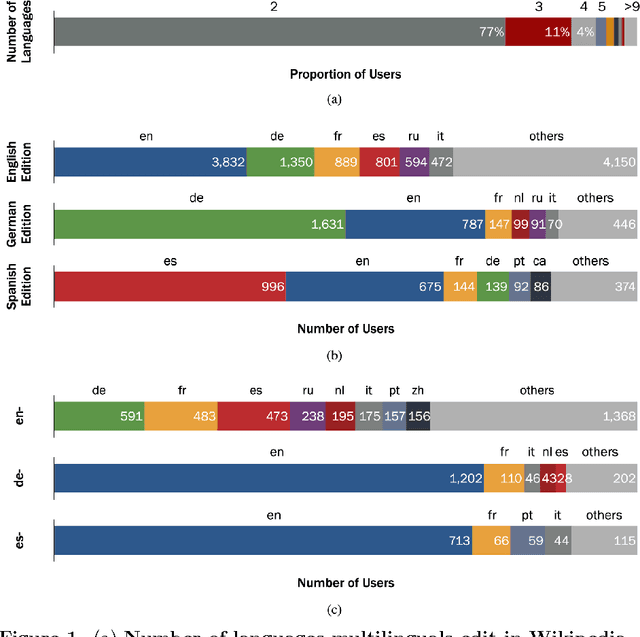

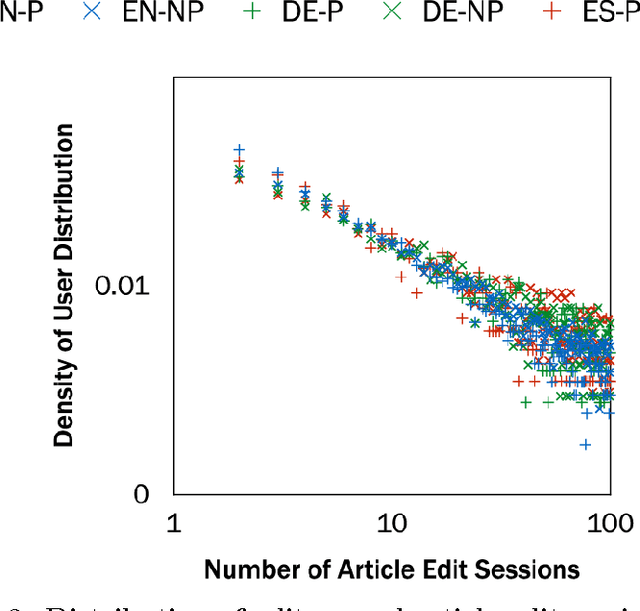

Abstract:Multilingualism is common offline, but we have a more limited understanding of the ways multilingualism is displayed online and the roles that multilinguals play in the spread of content between speakers of different languages. We take a computational approach to studying multilingualism using one of the largest user-generated content platforms, Wikipedia. We study multilingualism by collecting and analyzing a large dataset of the content written by multilingual editors of the English, German, and Spanish editions of Wikipedia. This dataset contains over two million paragraphs edited by over 15,000 multilingual users from July 8 to August 9, 2013. We analyze these multilingual editors in terms of their engagement, interests, and language proficiency in their primary and non-primary (secondary) languages and find that the English edition of Wikipedia displays different dynamics from the Spanish and German editions. Users primarily editing the Spanish and German editions make more complex edits than users who edit these editions as a second language. In contrast, users editing the English edition as a second language make edits that are just as complex as the edits by users who primarily edit the English edition. In this way, English serves a special role bringing together content written by multilinguals from many language editions. Nonetheless, language remains a formidable hurdle to the spread of content: we find evidence for a complexity barrier whereby editors are less likely to edit complex content in a second language. In addition, we find that multilinguals are less engaged and show lower levels of language proficiency in their second languages. We also examine the topical interests of multilingual editors and find that there is no significant difference between primary and non-primary editors in each language.
 Add to Chrome
Add to Chrome Add to Firefox
Add to Firefox Add to Edge
Add to Edge